How to Naturally Treat Hyperthyroidism in Cats
What is Hyperthyroidism in Cats?
Hyperthyroidism, also known as Thyrotoxicosis, is a common disease affecting middle-aged to older felines. It occurs when the two thyroid glands in a cat's neck produce excessive amounts of the thyroid hormone thyroxine (T3 and T4).
What Causes Hyperthyroidism in Cats?
The primary cause of hyperthyroidism in cats is a non-cancerous tumor called an adenoma. In rare cases, it can be due to a cancerous tumor known as thyroid adenocarcinoma. These benign growths form nodules on the thyroid lobes, leading to increased hormone production and a metabolic surge, affecting most body organs.
How Does Hyperthyroidism Affect a Cat's Body?
Excess thyroxine increases the metabolic rate, causing all body tissues to work harder and deplete vital resources like glucose, fats, and protein. This breakdown of muscle protein for fuel results in muscle loss. Vitamin stores are also depleted, leading to deficiencies, and cardiovascular and respiratory functions are impacted. Increased blood flow and stronger muscle contractions can thicken the heart's left ventricle, potentially causing heart failure if untreated.
Digestive functions are also heightened, leading to diarrhea. Despite increased hunger, weight loss occurs due to the rapid metabolism. Muscle tremors and high blood pressure (hypertension) are common complications, which can damage other organs.
Signs and Symptoms of Hyperthyroidism in Cats
Your cat may show some or all of these symptoms:
- Excessive hunger and increased appetite
- Weight loss
- Vomiting and/or diarrhea
- Increased thirst and urination
- Dull, matted, greasy coat
- Behavioral changes, nervous disposition, hyperactivity
- Muscle tremors
Natural Remedies for Hyperthyroidism in Cats
Our Tagiwig range includes the remedy Hyper T, a homeopathic blend designed to support your cat's immune response to hyperthyroidism. Hyper T helps reduce thyroid hormone production, supports metabolic function, increases weight, and aids the nervous system. This remedy has helped approximately 95% of our feline clients with hyperthyroidism.
While Hyper T is an over-the-counter product, we recognize that one product may not suit all cases. For cats that do not respond well, we offer personalized consulting services to develop a tailored treatment plan to address their specific needs.
Recent Articles

20% Off
All Cat Remedies
Lorem Ipsum is simply dummy text of the printing and typesetting industry. Lorem Ipsum has been the industry's standard dummy text ever since the 1500s, when an unknown printer took a galley of type and scrambled it to make a type specimen book. Lorem ipsum dolor sit amet, consectetur adipiscing elit. Vivamus leo ante, consectetur sit amet vulputate vel, dapibus sit amet lectus.



 Earn loyalty points everytime you shop
Earn loyalty points everytime you shop

